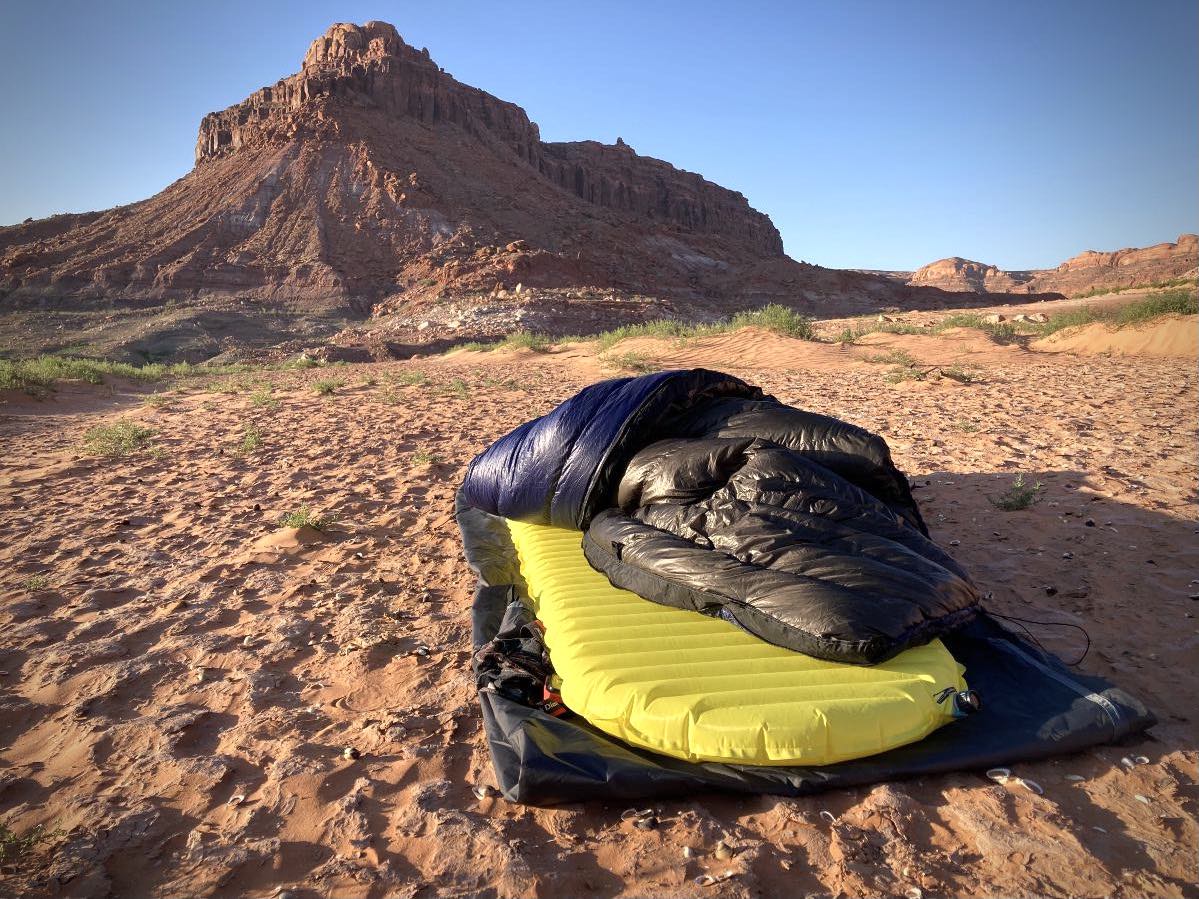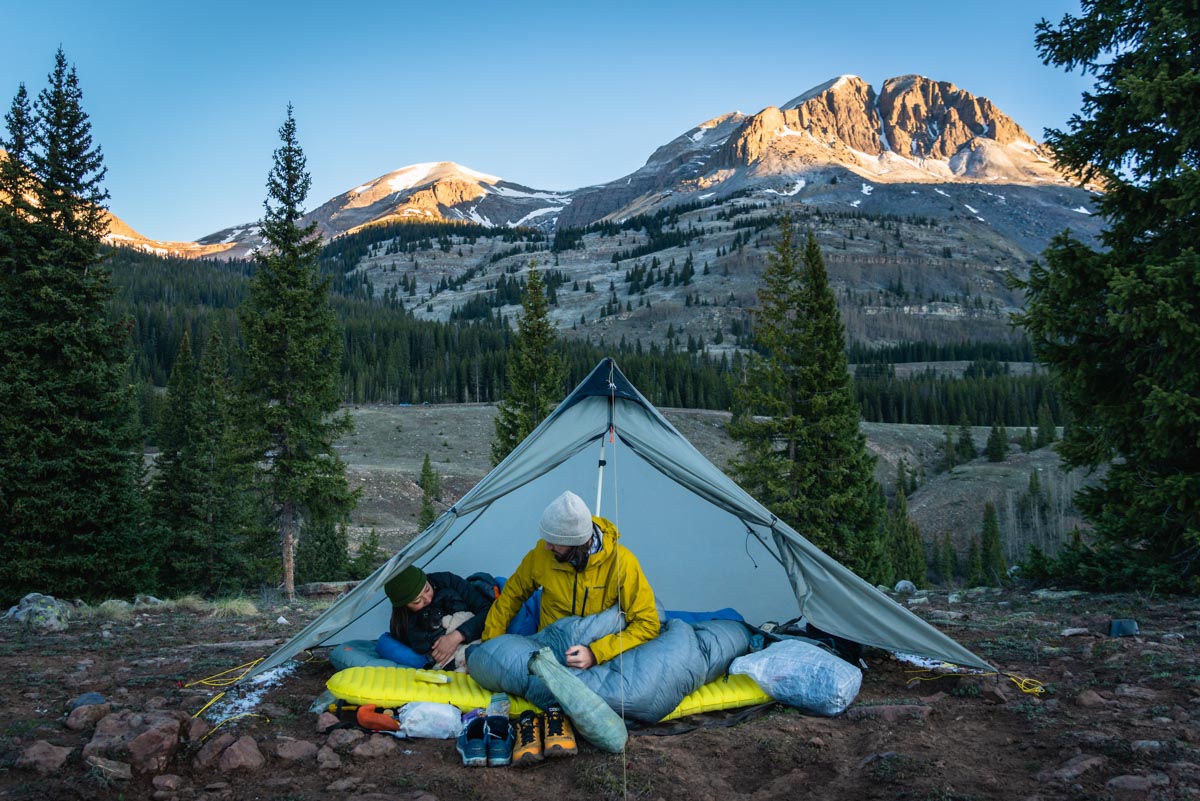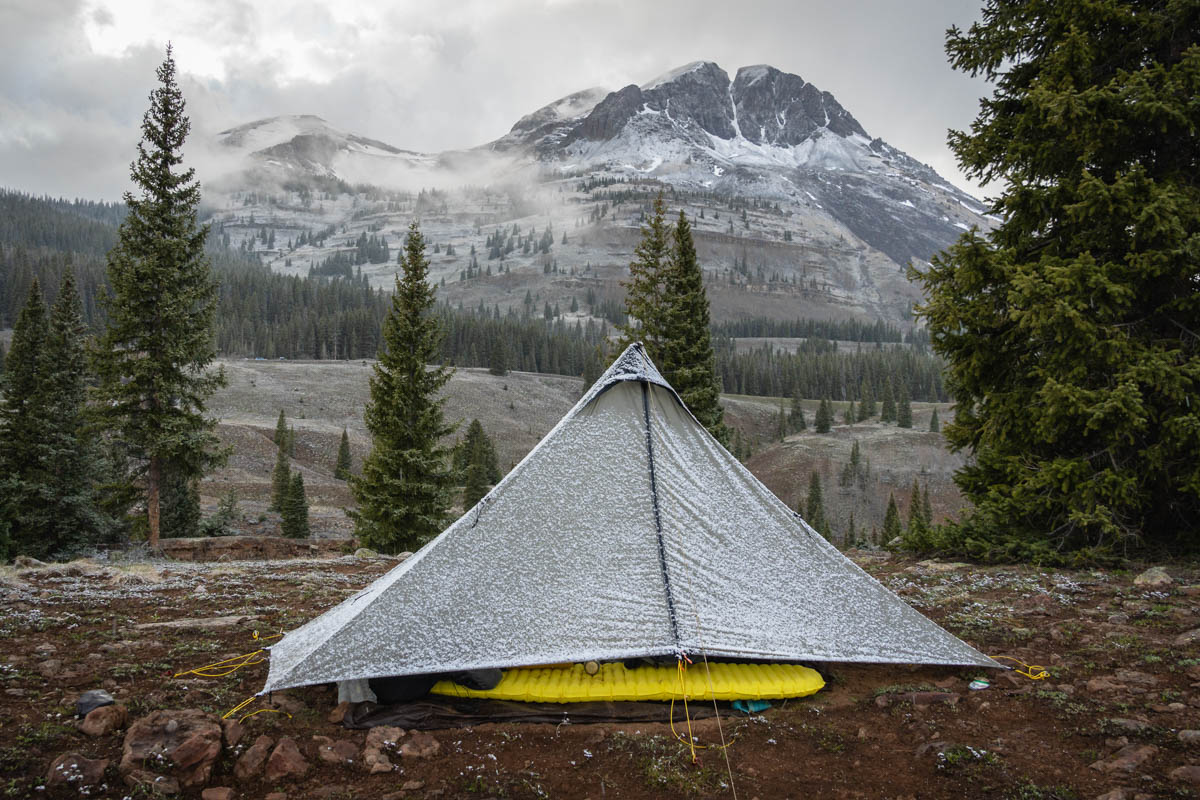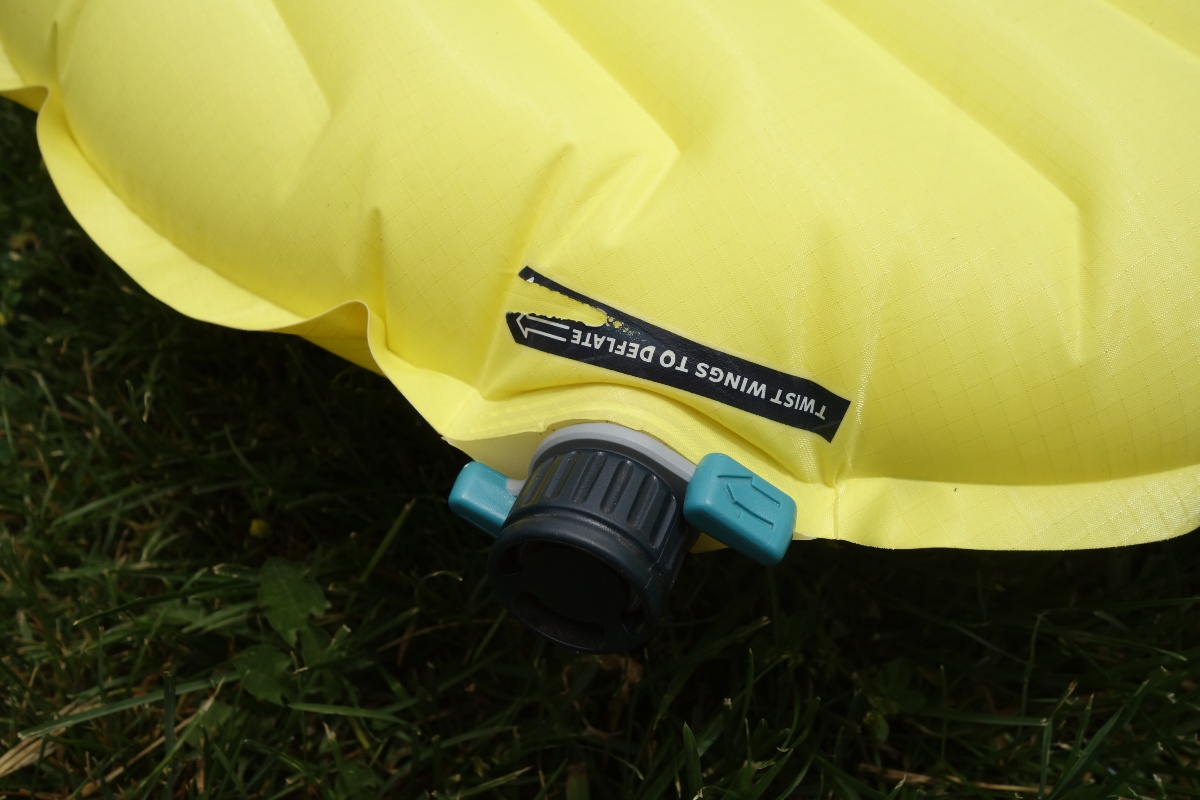The Therm-a-Rest NeoAir XLite Sleeping Pad ($200) is our choice for fastpacking and ultralight backpacking trips when a little comfort is warranted. It’s perfect for when you want to move fast and cover miles but also get into camp well before dark, leaving again only when the gray light of dawn is promising morning. The XLite is light, small, warm, and durable. But it’s not just a spartan tool, it’s also incredibly comfortable.
There is a women’s-specific version of this sleeping pad, the Therm-a-Rest Women’s NeoAir XLite Sleeping Pad, which we can recommend for any human five feet, six inches tall or under.
Some of our testers have been using versions of the Therm-a-Rest NeoAir XLite Sleeping Pad for over a decade. The original Therm-a-Rest NeoAir — pre-XLite — was released in 2009. It was similar in weight with a slightly lower R-value and a rectangular shape. By the way, R-value is a measure of a sleeping pad’s ability to prevent the loss of body heat to the cold ground. The higher the R-value, the warmer the pad will be.
When it was introduced, it was somewhat revolutionary, replacing folding foam pads for some of us and heavy self-inflating pads for others. One of our testers slept comfortably on this original NeoAir for two seasons as a wilderness ranger in the High Uintas of northern Utah. Of course, the original NeoAir was expensive, so it wasn’t easy for everyone to make the switch.
And it’s still expensive — $200 for an XLite in a size regular — but it has proven durable, comfortable, and warm, making that price worth it to many, including several of our testers. Out of all the sleeping pads we tested for our best ultralight sleeping pads guide, it was the one that rose most frequently to the top of each individual tester’s list, eventually receiving our best ultralight inflatable sleeping pad award.
Shop the Therm-a-Rest NeoAir XLite Sleeping PadShop the Therm-a-Rest Women’s NeoAir XLite Sleeping Pad

Testing the Therm-a-Rest NeoAir XLite Sleeping Pad on a night of cowboy camping in the Utah desert. Photo: iRunFar/Ben Kilbourne
Therm-a-Rest NeoAir XLite Sleeping Pad Weight
The Therm-a-Rest NeoAir XLite Sleeping Pad in a size regular weighs 13.3 ounces without the stuff sack or inflation bag and 15.2 ounces, including the inflation bag but not the stuff sack. We weighed it this way because we believe these are the two ways most ultralight backpackers and fastpackers will want to carry it.
Compared to other options, this pad is light. It weighs virtually the same as the two most popular folding foam pads for fastpacking: the Therm-a-Rest ZLite SOL Sleeping Pad — 13.8 ounces — and the NEMO Switchback Ultralight Sleeping Pad — 14.8 ounces — so folks who have been using those for years and want to upgrade without their pack base weight taking a hit can do so.
Therm-a-Rest NeoAir XLite Sleeping Pad Packed Size
Gear packability is a crucial metric for fastpackers because our packs are often so tiny. The Therm-a-Rest NeoAir XLite Sleeping Pad packs down very small at 9 x 4.1 inches (23 x 10cm). One of our testers packed this pad vertically beside an ultralight sleeping bag inside the Pa’lante Packs Joey fastpack — check out our Pa’lante Packs Joey review — for several Wasatch Mountains of Utah fastpacking trips this spring. Another tester sometimes folded it into a rectangle and slid it into the back pad compartment on her Gossamer Gear Murmur 36 Hyperlight Backpack to provide a bit of structure.
Therm-a-Rest NeoAir XLite Sleeping Pad Comfort
The Therm-a-Rest NeoAir XLite Sleeping Pad’s 2.5-inch thickness is more than enough to make the lumps of an uneven campsite imperceptible to sensitive sleepers all night long. We have appreciated that this reduces the amount of time we have to spend looking for a suitable campsite. With thinner foam pads, many of our testers search far and wide for perfectly flat and smooth campsites, because even a Douglas fir cone can disrupt sleep. If we’re carrying the XLite, we can be less picky.
While most testers noticed the crinkling sound this pad makes when tossing and turning, we weren’t all that bothered by it. Some tent partners weren’t so lucky. When you’re not the one doing the tossing and turning, the sound is much more annoying.
After testing both the Therm-a-Rest NeoAir XLite Sleeping Pad and the Therm-a-Rest NeoAir XTherm Max Sleeping Pad, several of our testers agreed that the rectangular XTherm Max, with its larger surface area, was more comfortable. The rectangular shape seemed to make that pad more stable than the XLite. In the interest of fastpacking, though, we can’t wish squareness on the XLite. Rounding the corners saves weight, and the comfort compromise of doing so is minimal.

iRunFar’s Ben Kilbourne tests the Therm-a-Rest NeoAir XLite Sleeping Pad on a chilly morning in the San Juan Mountains of Colorado. Photo: iRunFar/Eszter Horanyi
Therm-a-Rest NeoAir XLite Sleeping Pad Warmth
The iRunFar team found the Therm-a-Rest NeoAir XLite Sleeping Pad to be warm enough for just about any three-season fastpacking trip. This pad had the second-highest R-value of any pad in our best ultralight sleeping pad guide at 4.2.
One of our testers found the lower limit of the women’s version to be around 20 degrees Fahrenheit. When pushing the pad lower than that, she got a little cold and had to add layers. Other testers took the unisex XLite to about 22 degrees Fahrenheit without issue. For the vast majority of three-season fastpacking trips, the XLite will provide more than enough warmth.

Camping with the Therm-a-Rest NeoAir XLite Sleeping Pad up high in Colorado. Photo: iRunFar/Eszter Horanyi
Therm-a-Rest NeoAir XLite Sleeping Pad Durability
The 30-denier nylon fabric on both the top and bottom of the Therm-a-Rest NeoAir XLite Sleeping Pad strikes a fair balance of low weight and good durability. Sharp pine needles and rocks could eventually puncture the pad, but it’s easy to patch, making fabric durability of low concern to us.
A bigger concern is the aluminized film insulation inside the pad, which one of our testers has observed flaking off of a five-year-old XLite. We don’t know why this happened, and it has not happened to our other testers’ XLites. Fortunately, this pad has a lifetime warranty, and if something like this happens to your pad, Therm-a-Rest is likely to replace it.
Therm-a-Rest NeoAir XLite Sleeping Pad Inflation Bag and Valve
The Therm-a-Rest NeoAir XLite Sleeping Pad’s WingLock valve system took a little getting used to, but we ended up liking it. It’s composed of two stacked valves: the first opens or closes the valve completely, while the second engages the one-way feature. The round plastic opening at the bottom of the inflation bag snaps securely, if somewhat challengingly, onto the pad’s one-way valve.
The inflation bag is large, so it only takes about 10 bagfuls to fully inflate the pad. The instructions tell the user to blow into the bag and then squeeze that air into the pad, which is absurd, in our opinion. First, it’s unwise to introduce moisture into this sleeping pad as it could create cold spots. And second, simply lifting the bag toward the sky will fill it full of dry air with almost no effort.
It will be tempting to leave the 1.9-ounce inflation bag behind to lighten your load, but we recommend you bring it along and find an alternative use for it. It is made from a waterproof material, so we like to use it as a partial pack liner in low-volume fastpacking packs.
Therm-a-Rest NeoAir XLite Sleeping Pad Overall Impressions
After researching dozens of sleeping pads and testing 14 of them for our best ultralight sleeping pads guide, the Therm-a-Rest NeoAir XLite Sleeping Pad emerged as our favorite. Several of us at iRunFar had already been using this pad for years but were open to the possibility that something new could be better. Nothing was. We will be taking the XLite on many fastpacking trips for the foreseeable future and feel confident suggesting that you do too.
If you are a human five feet, six inches tall or under, we can also recommend the Therm-a-Rest Women’s NeoAir XLite Sleeping Pad. This pad is essentially a warmer and shorter version of the unisex XLite, probably created under the assumption that women sleep colder than men. Unfortunately, only one of our four female testers was short enough to fit on this pad. Likewise, colder-sleeping, taller male testers said they would consider buying this pad if it came in a 72-inch length.
That said, taller humans who sleep cold can always check out the Therm-a-Rest NeoAir XTherm Sleeping Pad or the Therm-a-Rest NeoAir XTherm Max Sleeping Pad, both of which come in a 72-inch length and have an amazing R-value of 6.9.
But for most fastpackers, the Therm-a-Rest NeoAir XLite Sleeping Pad will be ideal, which is why it’s the top picks in our best ultralight sleeping pad guide. No other sleeping pad we tested even came close to matching the balance of features that the XLite strikes. Some pads were lighter, some more comfortable, and some even warmer. But each of these attributes came at a cost: decreased durability in some cases and increased weight in others. The XLite finds a middle ground. It is light, durable, comfortable, packable, and warm.
Shop the Therm-a-Rest NeoAir XLite Sleeping PadShop the Therm-a-Rest Women’s NeoAir XLite Sleeping Pad
Call for Comments
- Have you successfully field-repaired an XLite?
- How long has your XLite lasted?
- Have you camped on snow with your XLite?
[Editor’s Note: If you’re affiliated (i.e., an employee, ambassador, etc.) with a brand, please share your relation in each of your comments on this article. Thanks!]






